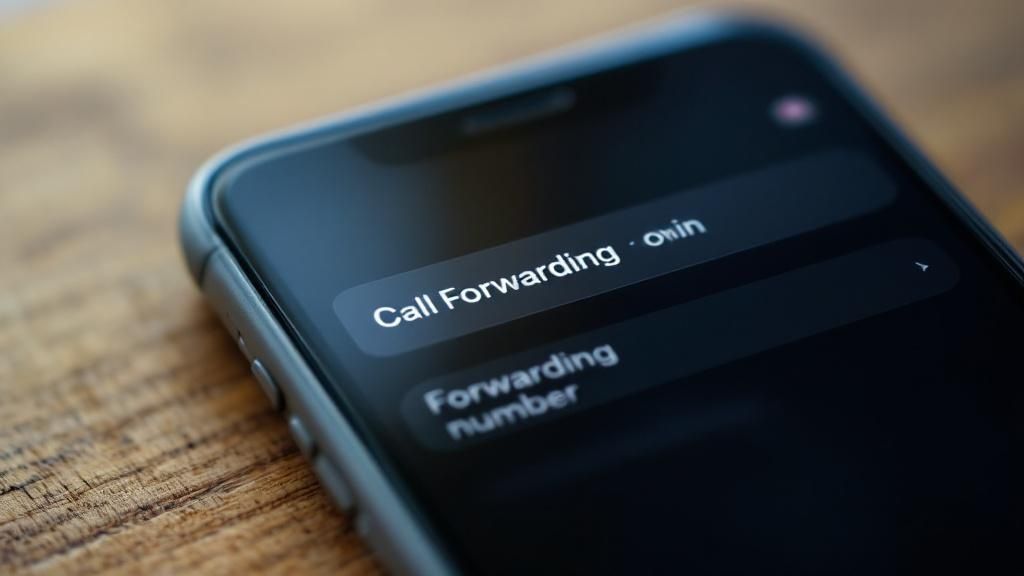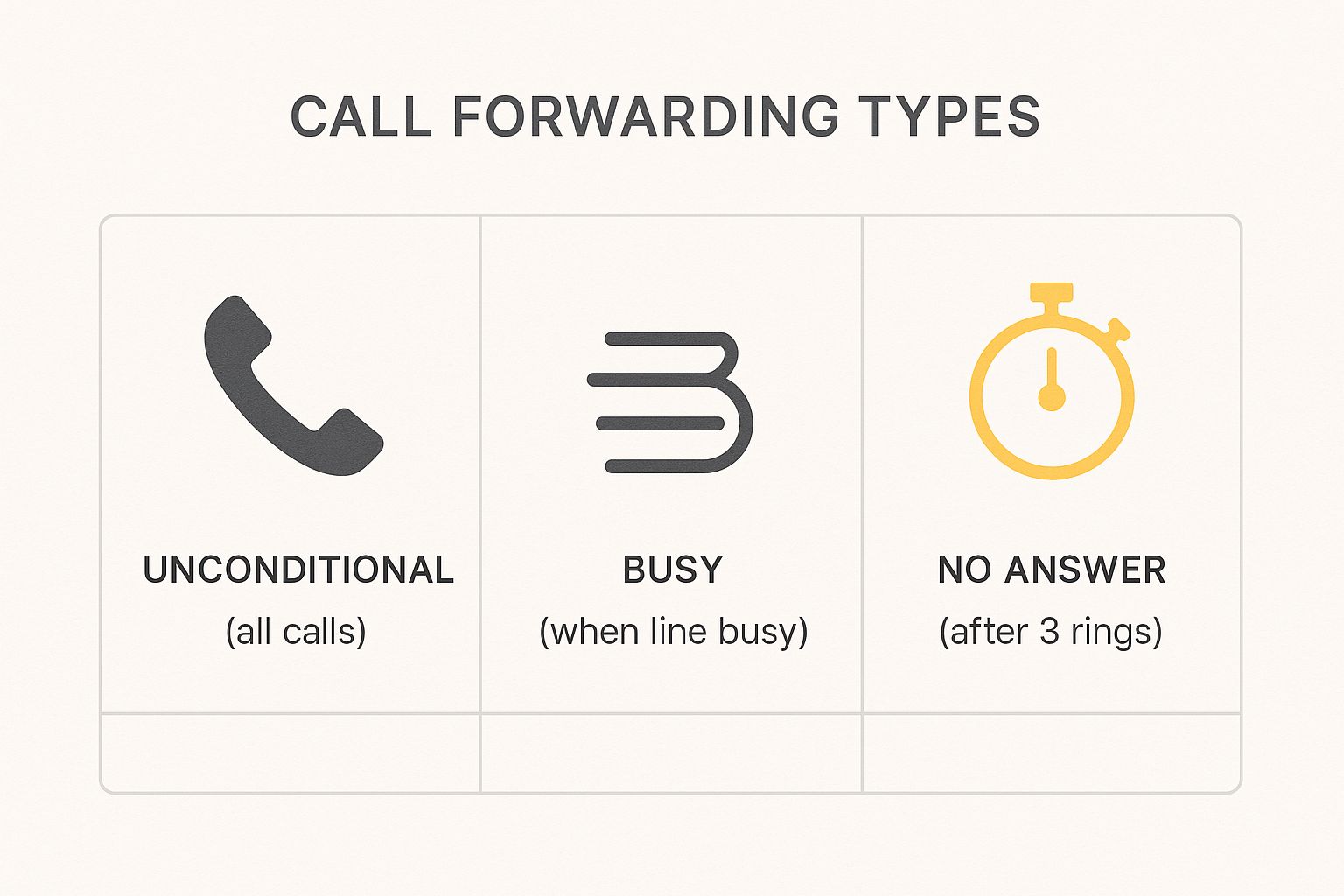Ever found yourself stuck in one place, waiting for an important call? Call forwarding is the simple phone feature that sets you free. It automatically redirects an incoming call from one phone number to another, essentially letting your office line ring on your mobile so you're never chained to your desk.
It’s the secret sauce that ensures you don’t miss that big client call, even when you're out on a job or grabbing a coffee.
What is Call Forwarding, Exactly?

Think of call forwarding as a smart digital receptionist or even a mail redirection service, but for your phone calls. Instead of having to be physically next to one specific phone, it gives you the freedom to answer calls wherever you are, on whatever device you choose.
This solves a huge headache for modern professionals who need to be accessible without being stuck in one spot. It's an absolute game-changer for small businesses, freelancers, and anyone who's constantly on the move but needs to maintain a professional front. You can advertise a single, permanent business number and take calls on your mobile, at your home office, or even have a team member pick them up.
Why It's a Must-Have for Modern Professionals
In today's fast-paced world, being available is everything. Call forwarding makes sure your communication flows smoothly and you never drop the ball.
Here’s why it matters:
- Work from Anywhere: Take business calls on your mobile while you’re travelling or working on-site, all without having to give out your personal number.
- Look Like a Pro: Present a single, unified business number to clients. It looks professional, even if your team is scattered all over the place.
- Never Miss a Lead: Cut down on missed calls by automatically bouncing them to a line that's free. Every call is a potential opportunity, after all.
This isn't just a "nice-to-have" feature; it's become crucial in Australia, where we live on our mobiles. Believe it or not, there are roughly 34.4 million cellular connections for a population of about 27 million. That means tons of us are juggling multiple devices for work and personal life. Call forwarding is the bridge that connects them all. If you’re curious, you can dig into the full report from DataReportal.
Once you get the hang of what call forwarding is, you can start looking at its different flavours. For instance, conditional call forwarding is a clever variation that only kicks in under specific rules, like when your line is busy or if you don't answer after a few rings.
How Your Calls Get Rerouted in an Instant
Ever wondered what’s happening behind the curtain when a call gets forwarded? It feels like magic, but it’s actually a slick process happening entirely within your provider's network. Think of it less like your phone doing the work and more like a clever digital switchboard operator handling everything for you.
When someone dials your number, the call doesn’t just zip straight to your phone. First, it hits your carrier's network (think Telstra, Optus, or your VoIP provider). That network instantly checks if you've got any call forwarding rules set up. It’s like a gatekeeper with a specific list of instructions just for you.
If a rule is active, the network grabs the call and immediately shoots it over to the number you’ve designated—whether that’s your mobile, a colleague’s desk phone, or your home office. This whole dance happens in milliseconds, so the caller has no idea their call just took a detour.
The Network vs. Your Phone
Now, where you set up your call forwarding really matters. You’ve generally got two choices, and they are not created equal.
- Network-Level Forwarding: You set this up directly with your service provider, usually through an online account or by dialling a few special codes. Because the network reroutes the call before it even tries to reach your phone, it's rock-solid. It’ll work even if your main phone is switched off, out of battery, or completely off the grid.
- Device-Level Forwarding: Some smartphones let you set up forwarding right in the settings. It’s handy, for sure, but it relies on your phone being on and connected. If your phone is dead or has no signal, it can’t receive the call to pass it along. The forward will most likely fail, and the caller gets sent straight to your original voicemail.
For anyone running a business, network-level forwarding is the only real choice. It guarantees your rules are followed 24/7, meaning you’ll never miss that critical call because of a dead battery or a bad signal patch.
By managing calls at the network level, you create a fail-proof system. Your availability is no longer tied to a single device's status, giving you true freedom and reliability in your communications.
Modern call management tools plug straight into this network level to add even more smarts. The OnSilent screenshot below shows how a simple interface can help you manage calls that have been forwarded or screened, giving you a crystal-clear overview of all your communications.

This is a great example of how today’s systems build on basic call forwarding, adding handy logs and smart actions that help you prioritise and respond way more efficiently.
Choosing the Right Type of Call Forwarding
Knowing you can redirect calls is one thing. But to really make call forwarding a powerhouse for your business, you need to pick the right type for your day-to-day grind. Not all forwarding is created equal, and choosing the right one is the key to staying efficient and looking professional.
Think of it like setting different "out of office" replies on your email. You wouldn't use the same generic message for a public holiday as you would for a quick 30-minute meeting. It's the same with your calls. Your forwarding rules should flex with your schedule, whether you're tied up with a client, already on another call, or just away from your phone.
Let's break down the main types so you can see how each one fits a different situation.

As you can see, your choice really boils down to the trigger. Are you redirecting every single call, or only the ones that come through under specific circumstances?
To make it even clearer, here’s a quick comparison of how the common forwarding types stack up against each other.
Comparing Call Forwarding Types
| Forwarding Type | Condition For Forwarding | Best Use Case |
|---|---|---|
| Unconditional | Always on. Every single call is rerouted. | When you need zero interruptions, like during workshops, holidays, or deep-focus work. |
| Conditional | Only when you're busy, don't answer, or are unreachable. | Everyday use for busy professionals who want a safety net to catch calls they can't take. |
| Time-Based | Based on the time of day or day of the week. | Managing after-hours calls, separating work and personal time, and routing to different teams. |
This table gives you a snapshot, but let’s dive a little deeper into what makes each one tick so you can pick the perfect setup for your workflow.
Unconditional Call Forwarding
This is the simplest of the lot—think of it as a master "forward all" switch. Once you flick on Unconditional Call Forwarding, every call that comes your way is instantly sent to another number. Your main phone won't even ring. It’s a complete, no-questions-asked redirection.
A great example is a consultant about to walk into an all-day client workshop. They can set this up to send every business call straight to their virtual assistant. This way, they know every caller is being looked after professionally while they can stay 100% focused on the client in front of them, with zero distractions.
Conditional Call Forwarding
Conditional forwarding is a bit more clever, acting like a smart assistant that only steps in when needed. It follows specific rules you set, only redirecting calls when certain conditions are met. This gives you way more flexibility and is easily the most popular choice for busy professionals who still want their main phone to be the first port of call.
Here are the most common conditions:
- When Busy: If you're already on a call, any new call that comes in gets automatically forwarded. No more frustrated callers hitting a busy signal.
- When Unanswered: If you don't pick up after a few rings (usually three or four), the call is rerouted to another number, like your mobile or a dedicated voicemail service.
- When Unreachable: If your phone is off, the battery's dead, or you're in a black spot with no signal, the network automatically sends the call somewhere it can be answered. It's a lifesaver for preventing calls from disappearing into the void.
Conditional forwarding is your safety net. It makes sure that even when you physically can't answer, your callers are still taken care of—which is absolutely vital for maintaining great customer service.
Time-Based Routing
Now we're getting into more advanced territory. Time-Based Routing is a sophisticated type of forwarding that sends calls to different places depending on the time of day or day of the week. It’s perfect for any business that needs to handle calls differently during and after business hours.
Picture a small real estate agency. They could set up their system to route all calls to the main office line between 9 AM and 5 PM on weekdays. But after 5 PM and on weekends, the rules automatically kick in to forward calls to an after-hours mobile or a specialised answering service. It’s a simple way to maintain a healthy work-life balance without ever missing a potential lead.
Unlock Key Benefits for Your Business

Knowing how call forwarding works is one thing, but seeing the real-world impact it can have on your business is where its true value clicks into place. A smart call forwarding strategy isn't just about bouncing calls from one phone to another; it’s about building a more flexible, professional, and responsive operation from the ground up.
For busy professionals, the most obvious win is freedom. Picture a contractor out on a job site, miles away from the office landline. With call forwarding, that office number rings straight through to their mobile, meaning they never miss a potential lead or an urgent client update. It’s a simple setup that turns their mobile into their main business tool, cutting the cord to a physical desk.
Elevate Your Customer Service
One of the biggest perks of call forwarding is how it immediately lifts your customer service game. When every single call is answered promptly by a real person, it completely changes the caller's experience. Instead of hitting a frustrating voicemail or a phone that just rings out, your clients get connected. That builds trust.
This is absolutely critical in service-based industries. The Australian call centre sector, valued at around AUD 2 billion, is built on call forwarding, using it to seamlessly route thousands of calls to agents who are actually available. This keeps wait times down and gets problems sorted fast—a lesson any small business can learn from.
By making sure someone is always there to respond, you can boost customer service efficiency and set a seriously high standard for looking after your clients.
Project a Professional Image and Find Balance
Looking professional is non-negotiable, no matter how big or small your business is. Call forwarding lets you advertise a single, dedicated business number while you juggle calls across different devices and even locations. This gives you a unified, established front, even if you’re a sole trader working from the home office.
Even better, it helps you carve out a healthier work-life balance. By setting up rules like those in conditional call forwarding, you can automatically send after-hours calls to a voicemail service or a colleague who's on the clock. You can learn more about setting up these rules in our guide on conditional call forwarding. It's the perfect way to stop work from creeping into your personal time, preventing burnout while making sure the business keeps ticking over.
Call forwarding empowers you to control your communications, not be controlled by them. It provides the structure to be highly responsive during work hours and completely present during your own time.
Upgrade Your Call Forwarding with OnSilent
Basic call forwarding is a fantastic tool, but let's be honest—it's a bit of a one-trick pony. It does one job, and one job only: it sends a call from point A to point B. What you do with that call once it hits your phone? Well, that's entirely on you.
This simple redirection is a great starting point, but a truly efficient setup needs a bit more intelligence to handle the calls that get through.
That’s where a tool like OnSilent comes in. It partners up with your existing call forwarding to add a crucial layer of smart management. Instead of just blindly sending every single call to your mobile, OnSilent acts as a clever gatekeeper, helping you screen, prioritise, and respond with incredible efficiency.
Go Beyond Simple Redirection
Think of it like this: standard call forwarding is the basic plumbing that brings water to your house. OnSilent is the advanced filtration and distribution system that makes sure you only get the clean water you need, right when you need it. It turns a simple utility into a properly refined workflow.
By adding this smart layer on top of your call forwarding, you suddenly get access to features that can save you hours every week:
- Smart Call Screening: OnSilent can spot and filter out spam or non-urgent calls before they even have a chance to interrupt your day.
- Automated Text Replies: For those calls you can't get to, the system can fire off an automatic, professional text message to the caller, letting them know you'll be in touch soon.
- Detailed Call Context: You get a crystal-clear log of every interaction, complete with caller ID and call history. This gives you the full picture before you even think about dialling back.
This kind of approach is quickly becoming essential for Australian businesses. In fact, as of 2024, over 31% of businesses had adopted virtual phone numbers with advanced forwarding to build a local presence and boost engagement. This trend, highlighted in a report by Aatrox Communications, really drives home the need for smarter call handling to manage the extra call volume.
OnSilent doesn’t replace your call forwarding; it completes it. It transforms a simple redirection feature into a comprehensive system for managing your most important business asset—your client communications.
A Smarter Way to Handle Business Calls
When you combine call forwarding with a dedicated management tool, you're not just redirecting calls—you're creating a seamless, professional communication strategy. The forward gets the call to the right device, and an app like OnSilent makes sure you handle it in the smartest way possible.
This synergy helps you stay organised, responsive, and focused on what actually matters.
This combination of technologies is a core part of modern business communication. By exploring different call management software, you can find a setup that perfectly fits your workflow, making sure no opportunity ever slips through the cracks.
Right, so at the end of the day, getting your head around call forwarding is about more than just flicking a switch on your phone. It’s about creating a smarter, more nimble way to work.
We’ve seen how this straightforward bit of tech can make sure you never miss that crucial call, whether you’re on-site, stuck in a meeting, or just stepped away from your desk for a minute. It's the real foundation for being able to work from anywhere.
By picking the right type of forwarding for the job—from the simple 'send all calls' approach to more specific rules for certain times or situations—you can tailor a system that actually fits how you work. This isn't just a gimmick; it seriously levels up your business by making you more responsive to customers, giving you a more polished, professional image, and helping you claw back some of that all-important work-life balance. It turns your phone from a chain into a tool that works for you, wherever you are.
Build Your Ideal Workflow
The trick is to stop thinking of call forwarding as a standalone feature and start seeing it as the heart of a modern communication plan. Its real power comes alive when you pair it with other smart tools that add another layer of efficiency.
A truly seamless strategy doesn't just bounce calls around; it helps you manage them with purpose. It gives you the clarity to prioritise what's important and the automation to handle the rest, keeping you productive and in control.
When you combine the rock-solid reliability of network-level forwarding with the smarts of a service like OnSilent, you’ve got a system that’s pretty much unbeatable. The forwarding makes sure the call gets to you, and then smart screening and automated responses handle the actual interaction with professional grace.
This one-two punch means you can stay connected, be responsive, and keep your focus on growing your business, no matter where you are. Your communication strategy finally starts working for you, not the other way around.
Got Questions About Call Forwarding? We’ve Got Answers.
Even once you get the hang of call forwarding, a few practical questions always seem to pop up. Let's run through the most common ones so you have everything you need to build a rock-solid communication strategy.
Does Call Forwarding Cost Extra in Australia?
This is a classic "it depends" situation. Many Aussie mobile and landline providers roll basic conditional call forwarding (like when your line is busy or unanswered) into their standard plans at no extra cost.
Where you might see charges is for the forwarded part of the call. This is often billed at standard local or national rates, depending on where the call is being sent. More complex setups, like unconditional forwarding or routing through a third-party VoIP service, can come with their own subscription fees. The golden rule? Always check with your provider to get the full picture of their fee structure and sidestep any bill shock.
Can I Forward My Landline to a Mobile Phone?
Absolutely! In fact, sending calls from a fixed landline to a mobile is one of the most popular and handy ways to use this tech. It’s a game-changer for small business owners who want that professional landline number on their website and van but need the freedom to take calls from anywhere.
Setting it up is usually a piece of cake. You can often do it yourself by dialling a few star codes on your landline handset or by hopping into your provider's online portal to tweak the settings.
Pro Tip: Always go for network-level forwarding from your carrier if you can. It’s the most reliable option because it reroutes calls even if your landline phone gets unplugged or the power goes out, meaning you never miss an important lead.
Will the Person Calling Know Their Call Is Being Forwarded?
Nope, and that’s the beauty of it. For the person on the other end, the whole process is completely invisible. They dial your number, and the call just connects. There’s no special tone, no message, nothing to give away that it’s been rerouted to a different phone or even a different city.
This is a huge plus for businesses trying to create a polished and professional vibe. It makes your entire communication system feel seamless, whether your team is all in one office or scattered across the country.
What Happens to Caller ID When a Call Is Forwarded?
Great question. The answer can change depending on your provider and how you’ve set things up. Most of the time, you'll see the original caller's number pop up on your screen when you get a forwarded call. This is incredibly useful because you immediately know who’s ringing and can answer the call the right way.
However, some older systems or specific services might show your own business number instead. If seeing the original caller's ID is a must-have for you, it’s worth confirming this feature with your phone provider before you commit. The more advanced systems will often give you even more context, so you know exactly where the call has come from.
Ready to turn your call forwarding from a simple feature into a powerhouse for your business? OnSilent adds a smart layer of call screening, automated replies, and detailed logs to make sure you handle every single call like a pro.
Find out how OnSilent can save you time and help you capture more opportunities today.

